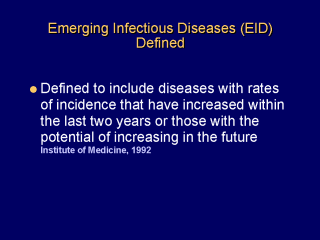 |
HIV/AIDS is one example of an emerging infectious disease (EID). The Institute of Medicine (1992) defines EIDs to include diseases whose rates of incidence have increased within the previous two years or those with the potential of rate increases in the near future.
Emerging infectious diseases are relatively new diseases (Legionnaire’s disease and ebola, for example) whereas reemerging infectious diseases are those whose incidence has increased after a period of control (cholera and tuberculosis).
|
